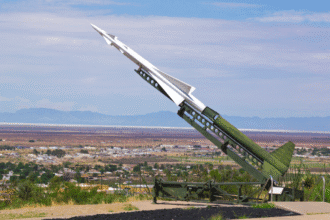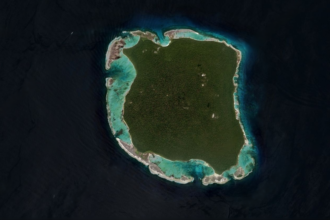With a deadly mix of high winds, thick woods, and abnormally dry weather driving the infernos, South Korea is fighting the largest wildfire in its history. The flames in the southeast had burnt through 35,810 hectares (88,500 acres) of land—an area about half the size of New York City Thursday. Tens of thousands of people have been displaced from their homes, and the death toll stands at 27. Widespread interruptions have resulted from the wildfires, also harming infrastructure, agricultural land, and electrical lines.
Residents have reported horrific events of fleeing the flames with little time to act. “The fire moved so fast, we barely had a chance to grab our belongings,” said one survivor. Local authorities have been overwhelmed by the fast development of the flames, so evacuation attempts have become especially difficult. Although many people still urgently need help, emergency shelters have been set up to serve those affected.
Starting the Wildfires: What?
Though unintentionally, authorities said the South Korean blaze started from human action. However, the actual offenders behind the fast spread are the dry conditions and the high winds across the inland areas. Lack of rain in recent weeks has reportedly made large forested areas a tinderbox for experts.
The steep geography of the afflicted areas makes firefighting activities very difficult. Fire crews find it difficult to reach the most affected locations, where flames keep spreading without control. Although aerial firefighting units have been sent in, heavy winds have hampered their activities.
Why is the fire spreading so rapidly?
North Gyeongsang province’s great concentration of pine trees is one of the key causes of the explosive spread of fires. Experts in forest disasters clarified that resin found in pine trees behaves like oil when burned. This resin fuels faster, more intense wildfires for a longer period. One of the worst-hit cities, Andong is well-known for its peaceable pine trees. These trees prove dangerous during wildfires even though they give local animals cover and food and can be windbreakers.
“Because South Korean forests feature a lot of pine trees, the areas are particularly vulnerable when fires start,” he said.
Pine trees are vulnerable to crown fires, wildfires that spread by burning the thick canopy of branches and leaves since they keep their needles all through the winter. This quality was very important in the quick and broad expansion of the flames the previous day. Further complicating containment is falling leaves and dried plants on the forest floor, which ignite the fires.
Is climate change aggravating wildfires?
Climate change is the main cause of these terrible fires, according to experts. “This South Korea wildfire has once again exposed the harsh reality of a climate crisis unlike anything we have experienced before,” the disaster head for the country said.
Weeks of rising temperatures above 20°C (68°F), an unprecedented occurrence for spring, have been underlining the conditions for these record-breaking flames. Global warming has apparently rendered these high temperatures up to five times more common. Particularly in combination with strong gusts, the intense heat dried out the soil and air, providing an excellent habitat for the fires to spread quickly.
As climatic trends change, meteorologists estimate that wildfires in South Korea could become more frequent and severe in the coming years. Rising temperatures, extended droughts, and shifting weather patterns are likely to make major wildfires a regular hazard.
What Difficulties Exist for Firefighters?
Strong winds and dense tree cover in the impacted areas provide significant difficulties for efforts at firefighting. Sadly, on Wednesday, a 73-year-old pilot perished after his firefighting helicopter crashed in Uiseong County. At least three more firemen have also perished fighting the flames.
Because wildfires are erratic, firefighters are always changing their plans. Certain places are too unsafe to visit; thus, authorities must rely on aircraft water drops. With changing winds prompting flames to veer abruptly, firefighters have said the conditions are among the toughest they have ever encountered.
Why are older people more at risk?
Of the 27 dead, most fall between the ages of 60 and 70. With one in five persons 65 years of age or above, South Korea boasts an aging population. The second-oldest province in North Korea could help to explain the quite high death toll: Older people should be evacuated from a disaster, especially considering mobility problems and health hazards.
Older folks could also find it difficult to understand or receive evacuation instructions in time. Three people living in an elderly care home perished in Yeongdeok County following the flames engulfing their car, tragically illustrating this. Only one of the four travelers escaped in time.
Concerned about the situation, the acting president said that the fact that many victims are elderly is “worrying.” To supervise relief initiatives, he gave the interior minister instructions to move to North Gyeongsang. Authorities are now concentrating on putting improved early warning systems and dedicated rescue teams into effect for older adults.
Are People Getting the Required Support?
The fire has claimed homes and livelihoods for many of the inhabitants. One Andong resident who left expressed her anguish, stating, ” Nobody in the community was ready. We had to go empty-handed, and all of our stuff was lost. Given that many of the residents are elderly, I hope the government can set up temporary shelters where people can live comfortably.
Volunteers and humanitarian organizations are distributing food, water, and necessities as part of continuous relief activities. Still, the scope of the calamity calls for more resources. Though reconstruction efforts are expected to take months, if not years, the government has pledged financial relief to those impacted.
What losses in history and culture have occurred?
Apart from the environmental and human damage, the South Korean wildfire has destroyed historical relics, therefore causing a major loss of culture. Two ancient temples, each more than 1,000 years old, lie among the rubble and contain valuables. One of these, the Gounsa temple, originated during the Silla dynasty (57 BC to 935 AD).
Local historians and cultural preservationists have expressed their grief at the damage done to these landmarks. “These temples were part of our history and legacy, not only places of worship,” one historian said. Assessments of the damage and investigation of future site restoration options are already under progress.
How may future wildfires be avoided?
Authorities are stepping up their attempts to tame the infernos and safeguard legacy as the fires rage on, therefore safeguarding lives as well as heritage. However, the catastrophe has underlined how urgently more aggressive policies are needed to counteract the growing hazards from problems with forest management and climate change.
Experts demand improved forest management plans involving controlled burns to cut extra vegetation and better monitoring methods to identify fires early on. South Korea is also Funding cutting-edge firefighting technologies, including satellite imaging and drones, to hasten response times.
Although the immediate focus is still on stopping the present wildfire, talks about how to stop such tragedies in the future are already in progress. Authorities underline that the best ways to reduce the hazards caused by upcoming wildfires will be preventive actions, climate adaptation, and community readiness.








